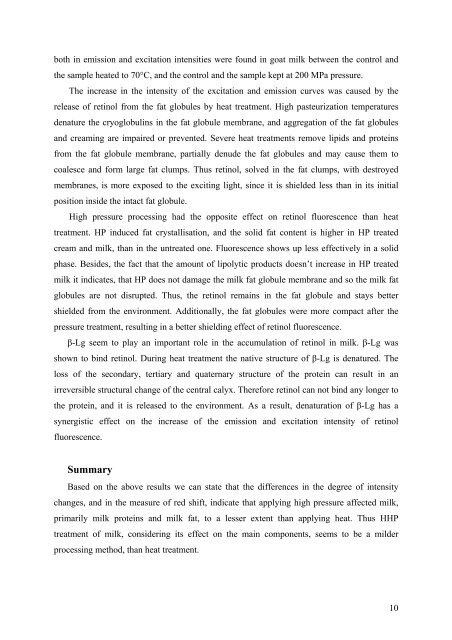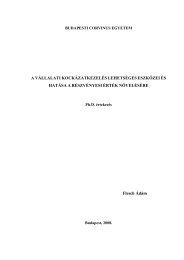Klára Pásztor-Huszár - Budapesti Corvinus Egyetem
Klára Pásztor-Huszár - Budapesti Corvinus Egyetem
Klára Pásztor-Huszár - Budapesti Corvinus Egyetem
Create successful ePaper yourself
Turn your PDF publications into a flip-book with our unique Google optimized e-Paper software.
oth in emission and excitation intensities were found in goat milk between the control and<br />
the sample heated to 70°C, and the control and the sample kept at 200 MPa pressure.<br />
The increase in the intensity of the excitation and emission curves was caused by the<br />
release of retinol from the fat globules by heat treatment. High pasteurization temperatures<br />
denature the cryoglobulins in the fat globule membrane, and aggregation of the fat globules<br />
and creaming are impaired or prevented. Severe heat treatments remove lipids and proteins<br />
from the fat globule membrane, partially denude the fat globules and may cause them to<br />
coalesce and form large fat clumps. Thus retinol, solved in the fat clumps, with destroyed<br />
membranes, is more exposed to the exciting light, since it is shielded less than in its initial<br />
position inside the intact fat globule.<br />
High pressure processing had the opposite effect on retinol fluorescence than heat<br />
treatment. HP induced fat crystallisation, and the solid fat content is higher in HP treated<br />
cream and milk, than in the untreated one. Fluorescence shows up less effectively in a solid<br />
phase. Besides, the fact that the amount of lipolytic products doesn’t increase in HP treated<br />
milk it indicates, that HP does not damage the milk fat globule membrane and so the milk fat<br />
globules are not disrupted. Thus, the retinol remains in the fat globule and stays better<br />
shielded from the environment. Additionally, the fat globules were more compact after the<br />
pressure treatment, resulting in a better shielding effect of retinol fluorescence.<br />
β-Lg seem to play an important role in the accumulation of retinol in milk. β-Lg was<br />
shown to bind retinol. During heat treatment the native structure of β-Lg is denatured. The<br />
loss of the secondary, tertiary and quaternary structure of the protein can result in an<br />
irreversible structural change of the central calyx. Therefore retinol can not bind any longer to<br />
the protein, and it is released to the environment. As a result, denaturation of β-Lg has a<br />
synergistic effect on the increase of the emission and excitation intensity of retinol<br />
fluorescence.<br />
Summary<br />
Based on the above results we can state that the differences in the degree of intensity<br />
changes, and in the measure of red shift, indicate that applying high pressure affected milk,<br />
primarily milk proteins and milk fat, to a lesser extent than applying heat. Thus HHP<br />
treatment of milk, considering its effect on the main components, seems to be a milder<br />
processing method, than heat treatment.<br />
10
















